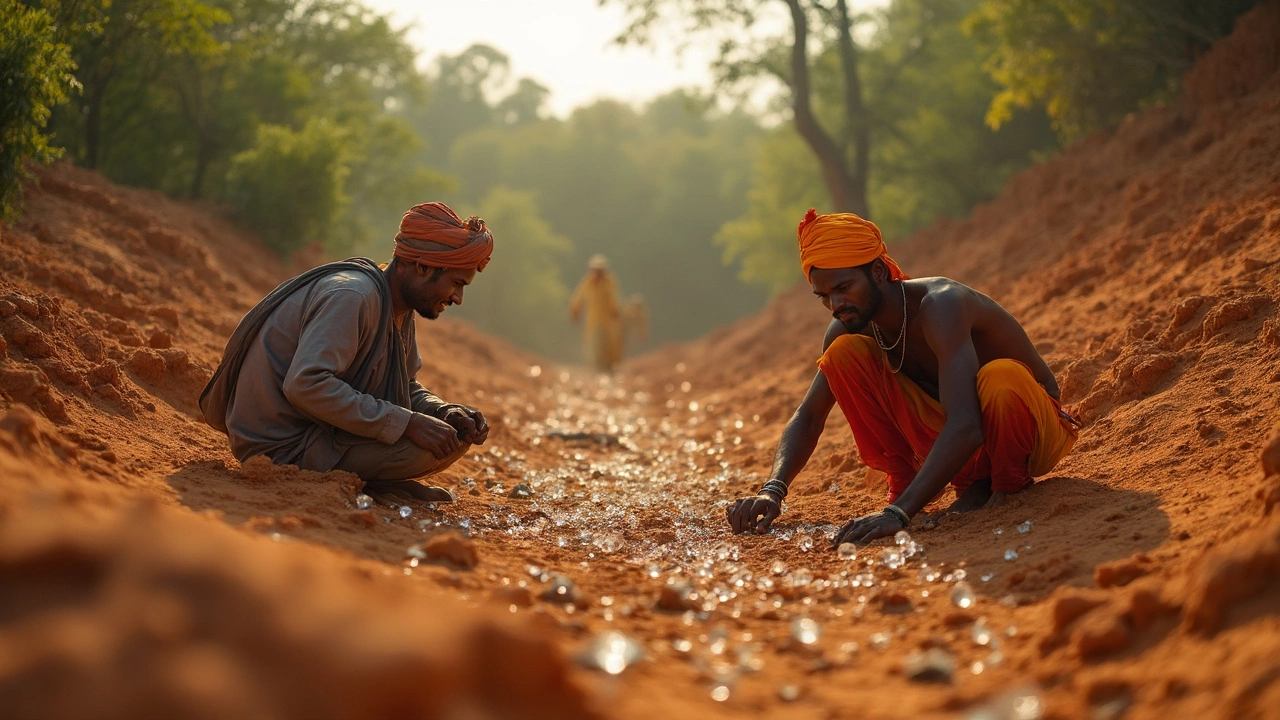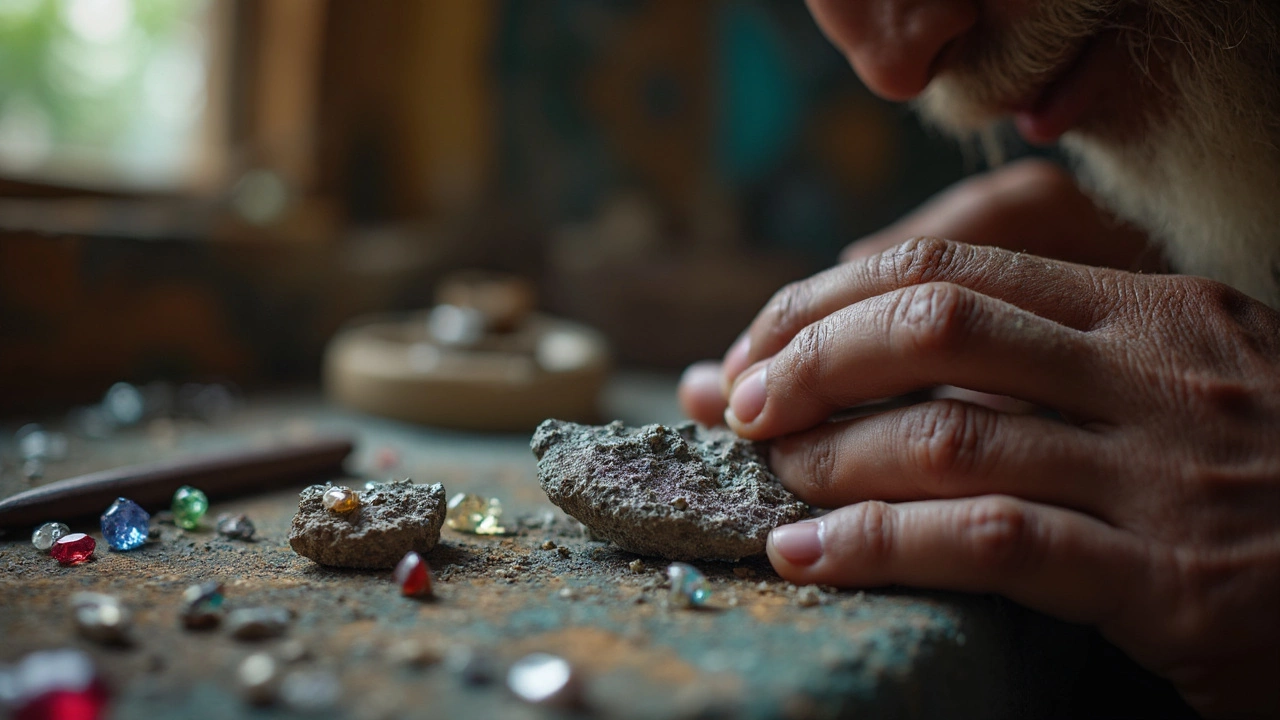
Ever wondered why people keep mentioning Panna when talking about diamond rings in India? It’s not just random hype—the buzz is real, and there’s a good reason. Panna’s name actually comes up because it’s home to one of the oldest and most talked-about diamond mining spots in the country. If you’re thinking about diamond rings, there’s a decent chance your sparkly stone might have roots in this small Madhya Pradesh town.
More than just the setting for old treasure tales, Panna is still producing diamonds today. These stones don’t just have bragging rights for being local—they’re known for their clarity and natural beauty. Jewelers across India love working with them, and buyers often look for that connection when picking out rings for big moments, like engagements or anniversaries.
- Panna: Not Just a Dot on the Map
- A Quick Dive into Panna’s Diamond History
- What Makes Panna Diamonds Different?
- Diamond Mining in Panna: How It Works
- How Panna Diamonds Shape India's Jewelry Scene
- Tips for Buying a Panna Diamond Ring
Panna: Not Just a Dot on the Map
Panna might look like any other small town on a map, but trust me, it’s a heavy hitter in the gem business. Tucked away in Madhya Pradesh, about 380 km from Bhopal, Panna is actually the only place in India where people have been legally mining diamonds for decades. You’ll find its name right up there with world-famous diamond spots—even the Indian government recognizes it as a major mineral resource hub.
The area buzzing with activity is known as the Panna Diamond Belt, stretching roughly 80 kilometers along the river Ken. It’s not just big on scale; it’s unique because no other part of India offers commercial diamond mining like this. The official diamond mines here are managed by the National Mineral Development Corporation (NMDC), with some patches also given to locals by lottery each year.
Check out this data on Panna’s diamond boom:
| Fact | Detail |
|---|---|
| Location | Panna District, Madhya Pradesh |
| Largest Producing Mine | Panna Mine (NMDC-run) |
| Diamond Belt Length | ~80 km along Ken River |
| Annual Official Output | Up to 10,000 carats (depending on the year) |
| Unique Feature | Only legal diamond mining area in India |
Another cool thing: Panna is not just about mining. The town's hustle supports thousands of families, and every year, the district draws in treasure hunters and tourists who want a piece of the diamond scene. If you’re hunting for a Panna diamond ring, knowing your gem comes from such a legendary spot just adds to the story.
A Quick Dive into Panna’s Diamond History
Panna’s connection with diamonds isn’t a new thing. Way back in the 16th century, explorers and traders were already whispering about the diamond fields here. The Mughal emperors loved stones from this area, and some even found their way into royal crowns and swords. Britain’s East India Company jumped on the scene too, making Panna’s diamonds known beyond India’s borders by the 1800s. If you look up old documents, you’ll see mentions of Panna’s diamonds in letters and trade reports from those days.
After India’s independence, the diamond business in Panna didn’t slow down. In 1955, the Indian government took charge and started running the mines through the National Mineral Development Corporation (NMDC). Since then, tons of rough diamonds have been pulled out every year. These aren’t always giant stones—they mostly weigh less than a carat—but collectors and jewelers still line up for them because of their natural charm and local story.
| Year | Major Event |
|---|---|
| 16th Century | Start of known diamond mining; Mughal interest |
| 1820s | East India Company recognizes commercial value |
| 1955 | NMDC takes over production after independence |
| Ongoing | Panna remains India’s only active diamond mining region |
Here’s a quick fact that might surprise you: Panna is still the Panna district with India’s only working diamond mines. No other place in the country has managed to keep up consistent diamond mining like this. Each stone gets a government certificate, which helps with resale and authenticity.
For anyone shopping for diamond rings in India, knowing this history gives you bragging rights—and you’ll understand why a “Panna diamond” isn’t just a stone, but a piece of living heritage.
What Makes Panna Diamonds Different?
So what’s the big deal about Panna diamonds anyway? For starters, these diamonds are all-natural, found right in the soil, not created in a lab. The area around Panna is one of the only places in India where you get natural diamonds, and that alone makes them a huge deal for anyone who wants real-deal sparkle in their ring.
Another thing people love about Panna diamonds is their transparency and shine. You might hear the term "luster" thrown around in diamond shops. Panna stones usually have a strong luster, making them look super clear when they’re cut and polished. They don’t just dazzle in the shop — they keep that shine when you actually wear them, which is what everyone’s looking for with a diamond ring.
The structure of these diamonds is different, too. Geologists say Panna diamonds have fewer flaws compared to others found in India, so you’re less likely to find cloudy spots or cracks inside. That’s especially important if you’re picky about the look of your ring or want to pass it down one day. Here’s a quick breakdown of what makes Panna stand out, compared to other sources:
| Feature | Panna Diamonds | Other Indian Diamonds |
|---|---|---|
| Origin | Natural, from Panna mines | Some natural, some lab-made |
| Clarity | High clarity, fewer inclusions | Varies, more flaws common |
| Brilliance | Strong shine/luster | Often less dazzling |
| Shapes Found | Mostly octahedral, dodecahedral | Mixed, sometimes irregular |
One more bonus if you care about local buying: Panna diamonds support traditional diamond miners and their families right here in India. Buying a Panna diamond doesn’t just get you a beautiful stone—it keeps a time-honored craft alive.

Diamond Mining in Panna: How It Works
When you hear about Panna’s diamond mines, think less of giant machines and more of a local setup. Mining here relies on tried-and-true methods that barely changed in decades. The area runs both government-owned and private mines, with the Madhya Pradesh government controlling the legal mining under its Panna Diamond Mines Project.
Most of the mining is done through an open-cast method. Surface soil is stripped away to reach gravel-filled pits where diamonds hide. Miners dig small trenches, scoop out gravel, and then wash it in simple sieves. This process might sound old-school, but it actually helps in picking out undamaged stones. Hand sorting is common, too—workers spot those raw, uncut diamonds based on a trained eye and a bit of luck.
The government auctions mining rights to locals, and there are about 200 active mining leases at any time. Officially, only licensed miners can dig here, which cuts down on illegal mining but doesn’t wipe it out completely. The National Mineral Development Corporation (NMDC) also manages a notable underground mine called Majhgawan, the only organized underground diamond mine in India.
Check out these quick facts about Panna diamond mining:
| Detail | Fact |
|---|---|
| Annual Rough Diamond Output | ~10,000 carats |
| Mining Leases (official) | About 200 |
| Main Mining Method | Open-cast/manual |
| Major Management | Madhya Pradesh Govt. & NMDC |
A handy tip: diamonds found here go through a government auction, so the supply chain is pretty transparent. If you hear about Panna diamonds being bought off the street, stay clear—it’s probably not legal or up to mark. The best stones, especially for jewelry, come from those official channels and are carefully screened for quality.
How Panna Diamonds Shape India's Jewelry Scene
Panna diamonds pack more punch in the Indian jewelry market than most people realize. For starters, Panna is the only active diamond mining zone in the whole of Asia, and it pumps out thousands of carats every year. That's not just cool trivia—the steady stream of diamonds coming from this region actually keeps a lot of jewelers in business, especially those who want locally sourced stones.
Now, what really makes these diamonds special for the jewelry crowd is their natural sparkle. While places like Surat are famous for cutting and polishing, the raw material often comes from Panna. So next time you see a diamond ring in India, especially one that’s claimed to be natural and untreated, chances are fair it's got Panna roots.
Panna diamonds appeal to buyers for lots of reasons. Shops and brands market the local origin, which means people looking for something genuinely Indian love this touch. Artisans appreciate how easy these diamonds are to shape and set, saving time and effort. That’s why you’ll spot Panna stones not just in traditional chunky rings but in a ton of modern designs too.
- Many prominent jewelry stores in big cities like Mumbai, Delhi, and Kolkata actively source their stones from Panna because of the consistent supply.
- Panna diamonds are especially popular during wedding seasons when demand for diamond rings shoots up fast.
- Green credentials? These stones travel less compared to imports, so eco-conscious buyers get a bonus.
Take a look at how significant the Panna mines are for India's diamond scene:
| Year | Panna Diamond Output (carats) | Share in Indian Market (%) |
|---|---|---|
| 2019-20 | 37,000 | Over 90% |
| 2021-22 | 39,500 | 95% |
| 2023-24 | 41,000 | 96% |
So when you see a diamond ring that spotlights its Panna heritage, it's not just marketing talk. These gems really do shape what’s on offer at Indian jewelry counters—even my buddy who got engaged last year was amazed when his jeweler mentioned the Panna connection. If you're all about authenticity and supporting local, it's hard to top a Panna diamond.
Tips for Buying a Panna Diamond Ring
Looking to pick up a diamond ring from Panna? Doing a bit of homework can make a huge difference, especially since not all diamonds are created equal in terms of quality or value. Let’s break down some practical tips so you don’t end up overpaying or getting fooled by fakes.
- Know the Source: Real Panna diamonds usually come with a certificate from a recognized gem authority, like the Gemological Institute of India or the International Gemological Institute. If the seller can’t show you legit paperwork, be wary.
- Check the 4Cs: This means Carat, Cut, Clarity, and Color. Panna diamonds are famous for their natural clarity, but always double-check with a jeweler. Ask about the 4Cs, so you know exactly what you’re buying.
- Look for Local Markings: Most jewelers in Madhya Pradesh who deal with Panna diamonds stamp their jewelry with a certification mark. These make it easier to trace the diamond's journey and prove it's not imported or synthetic.
- Compare Prices: Panna diamonds are usually a bit pricier than lesser-known stones, but not always. Use the table below as a ballpark guide, but always compare prices among different shops.
- Ask About Mining Practices: The best dealers are open about how their diamonds are sourced. Stones from government-leased mines in Panna are more likely to be tracked and responsibly mined.
Check how Panna diamonds stack up against others, just for peace of mind:
| Source | Average Price/Carat (INR) | Common Clarity | Typical Certification |
|---|---|---|---|
| Panna | 55,000–80,000 | VS to SI | GII, IGI |
| Botswana | 45,000–70,000 | SI to I | IGI |
| Russia | 50,000–75,000 | VS to SI | GIA, IGI |
The most important thing is to make sure your diamond is really from Panna, which is a big selling point in the world of diamond rings india. If you’re buying for a big occasion, don’t rush the process. Bring someone you trust, ask questions, and get everything written down. And yeah—don’t forget to look at the diamond under natural light before you decide!


